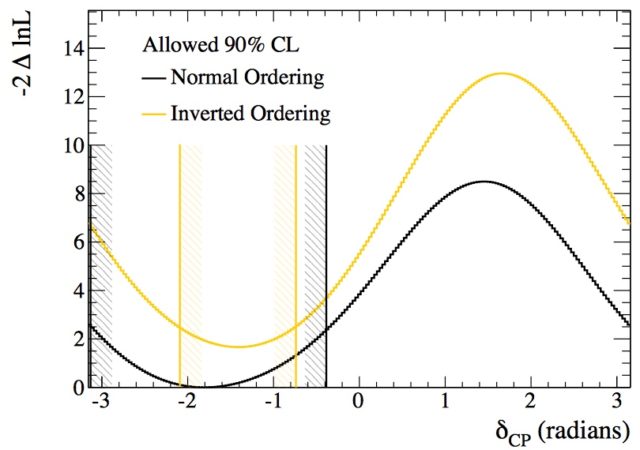First joint oscillation analysis of Super-Kamiokande atmospheric and T2K accelerator neutrino data
The Super-Kamiokande and T2K collaborations present a joint measurement of neutrino oscillation parameters from their atmospheric and beam neutrino data. A common neutrino interaction model has been developed for the events of the two experiments which overlap in energy, and correlations between their detector systematic uncertainties were evaluated. Using 3244.4 days of atmospheric data and a beam exposure of respectively 19.7E20 and 16.3E20 protons on target in neutrino and antineutrino running modes, we find an exclusion of the CP-conserving value of the Jarlskog invariant with a significance varying between 1.9σ and 2.0σ depending on the analysis considered, a limited preference for the normal mass ordering (MO), and no strong preference for the θ23 octant.
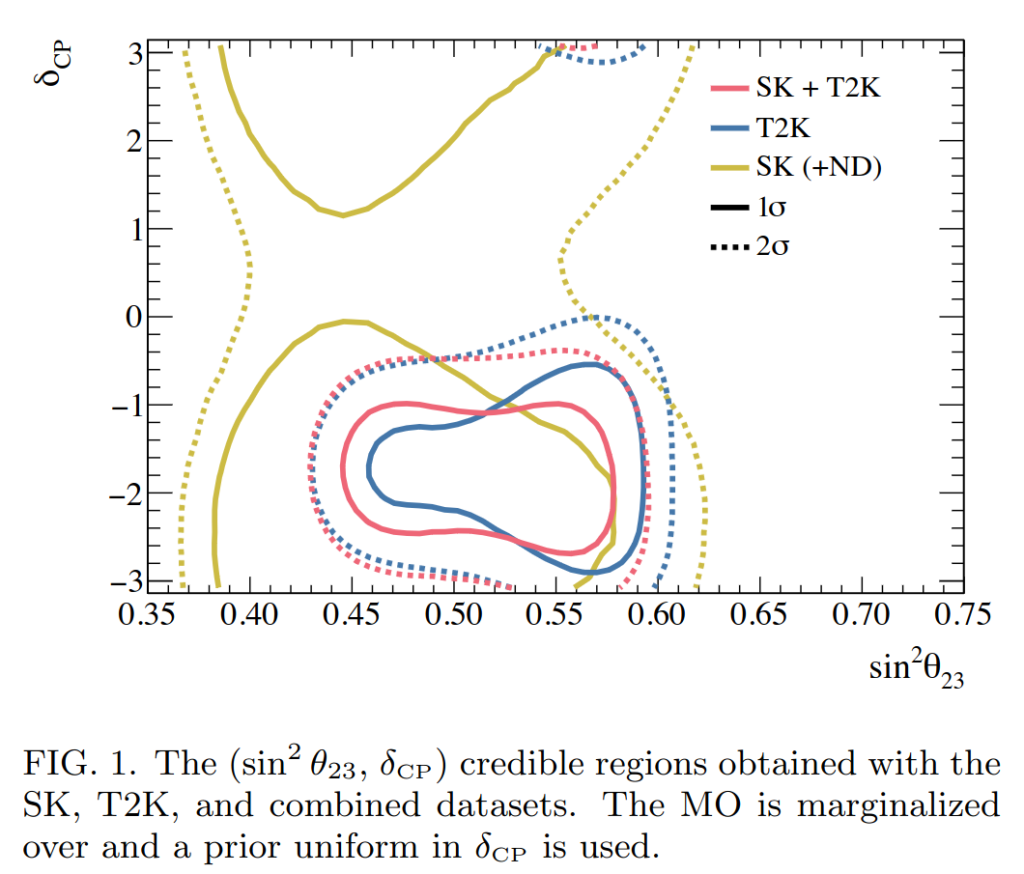
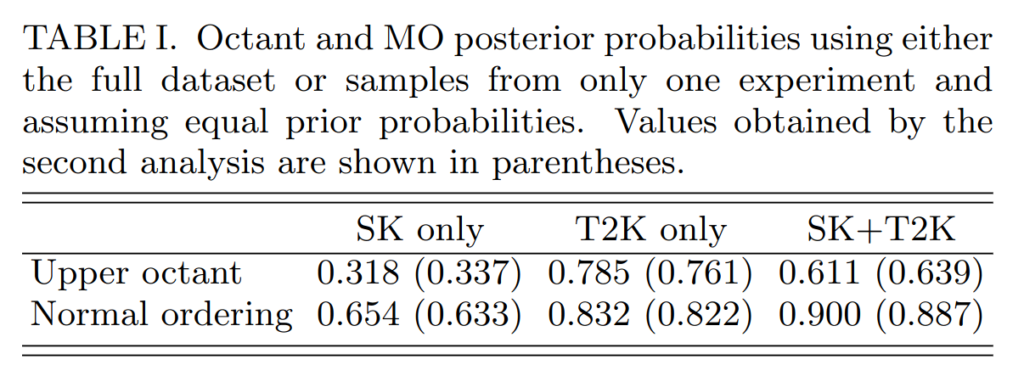
arXiv preprint : https://arxiv.org/pdf/2405.12488
Updated T2K measurements of muon neutrino and antineutrino disappearance using 3.6E21 protons on target
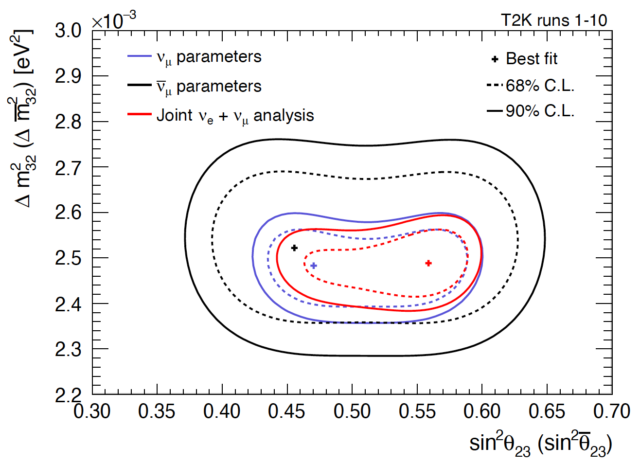
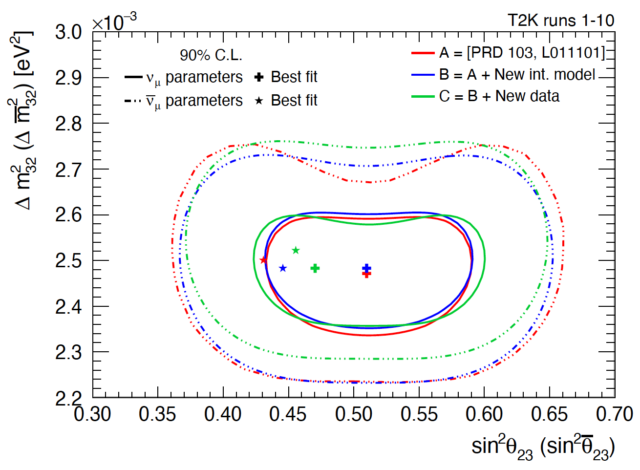
arXiv preprint : https://arxiv.org/pdf/2305.09916
Data release : https://zenodo.org/record/7929975
Measurements of neutrino oscillation parameters from the T2K experiment using 3.6E21 protons on target
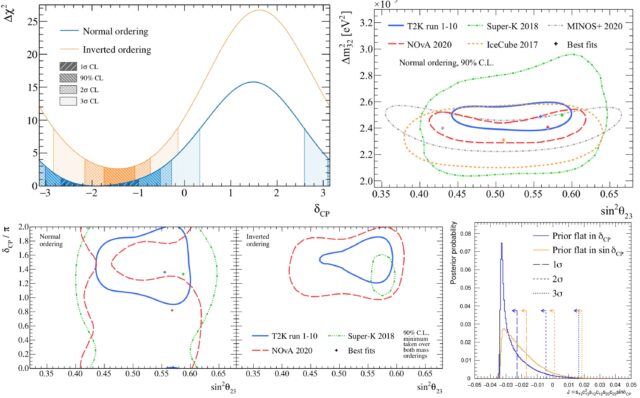
Search for Electron Antineutrino Appearance in a Long-baseline Muon Antineutrino Beam
arXiv preprint: https://arxiv.org/abs/1911.07283
DOI: https://doi.org/10.1103/PhysRevLett.124.161802
Reference: Phys.Rev.Lett. 124 (2020) 16, 161802
Improved constraints on neutrino mixing from the T2K experiment with 3.13×10E21 protons on target
T2K measurements of muon neutrino and antineutrino disappearance using 3.13E21 protons on target
Constraint on the matter–antimatter symmetry-violating phase in neutrino oscillations
The charge-conjugation and parity-reversal (CP) symmetry of fundamental particles is a symmetry between matter and antimatter. Violation of this CP symmetry was first observed in 19641, and CP violation in the weak interactions of quarks was soon established2. Sakharov proposed3 that CP violation is necessary to explain the observed imbalance of matter and antimatter abundance in the Universe. However, CP violation in quarks is too small to support this explanation. So far, CP violation has not been observed in non-quark elementary particle systems. It has been shown that CP violation in leptons could generate the matter–antimatter disparity through a process called leptogenesis4. Leptonic mixing, which appears in the standard model’s charged current interactions5,6, provides a potential source of CP violation through a complex phase δCP, which is required by some theoretical models of leptogenesis7,8,9. This CP violation can be measured in muon neutrino to electron neutrino oscillations and the corresponding antineutrino oscillations, which are experimentally accessible using accelerator-produced beams as established by the Tokai-to-Kamioka (T2K) and NOvA experiments10,11. Until now, the value of δCPhas not been substantially constrained by neutrino oscillation experiments. Here we report a measurement using long-baseline neutrino and antineutrino oscillations observed by the T2K experiment that shows a large increase in the neutrino oscillation probability, excluding values of δCP that result in a large increase in the observed antineutrino oscillation probability at three standard deviations (3σ). The 3σ confidence interval for δCP, which is cyclic and repeats every 2π, is [−3.41, −0.03] for the so-called normal mass ordering and [−2.54, −0.32] for the inverted mass ordering. Our results indicate CP violation in leptons and our method enables sensitive searches for matter–antimatter asymmetry in neutrino oscillations using accelerator-produced neutrino beams. Future measurements with larger datasets will test whether leptonic CP violation is larger than the CP violation in quarks.
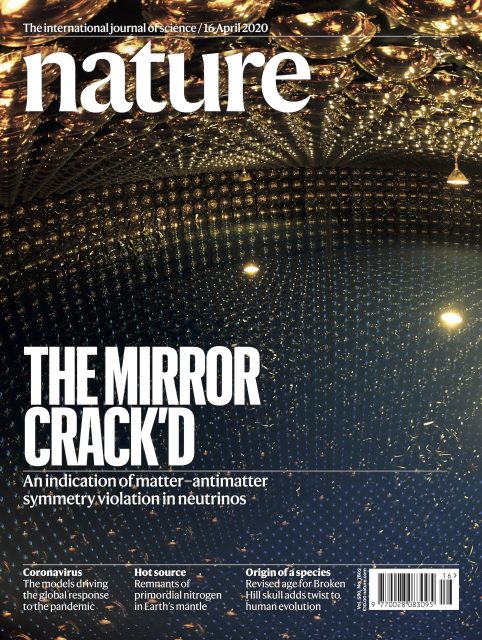
Search for CP violation in Neutrino and Antineutrino Oscillations by the T2K experiment with 2.2E21 protons on target
The T2K experiment measures muon neutrino disappearance and electron neutrino appearance in accelerator-produced neutrino and antineutrino beams. With an exposure of 14.7(7.6)×1020 protons on target in (anti)neutrino mode, 89 electron neutrino candidates and 7 electron antineutrino candidates were observed while 67.5 and9.0 are expected for δCP=0 and normal mass ordering. The obtained 2σ confidence interval for the CP violating phase, δCP , does not include the CP-conserving cases (δCP=0, π). The best-fit values of other parameters are sin^2_θ23 = 0.526+0.032 −0.036 and ∆m^2_32 = 2.463 ± 0.065E−3 eV2/c4 .
Published in Phys.Rev.Lett. 121 (2018) no.17, 171802
DOI: 10.1103/PhysRevLett.121.171802
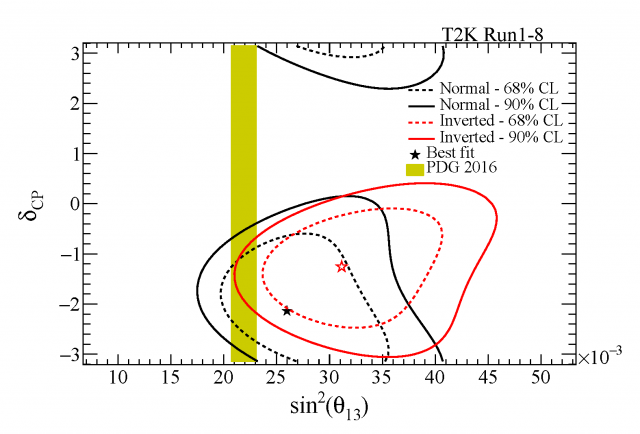
Updated T2K measurements of muon neutrino and antineutrino disappearance using 1.5e21 protons on target
We report measurements by the T2K experiment of the parameters θ23 and ∆m232 governing the disappearance of muon neutrinos and antineutrinos in the three flavor neutrino oscillation model. Utilizing the ability of the experiment to run with either a mainly neutrino or a mainly antineutrino beam, the parameters are measured separately for neutrinos and antineutrinos. Using 7.482 × 1020 POT in neutrino running mode and 7.471 × 1020 POT in antineutrino mode, T2K obtains sin2(θ23) = 0.51+0.08−0.07 and ∆m232 = 2.53+0.15−0.13 × 10−3 eV2/c4 for neutrinos, and sin2(θ̅23) = 0.47+0.25−0.07 and ∆m̅232 = 2.55+0.33−0.27 × 10−3 eV2/c4 for antineutrinos (assuming normal mass ordering). No significant differences between the values of the parameters describing the disappearance of muon neutrinos and antineutrinos were observed.
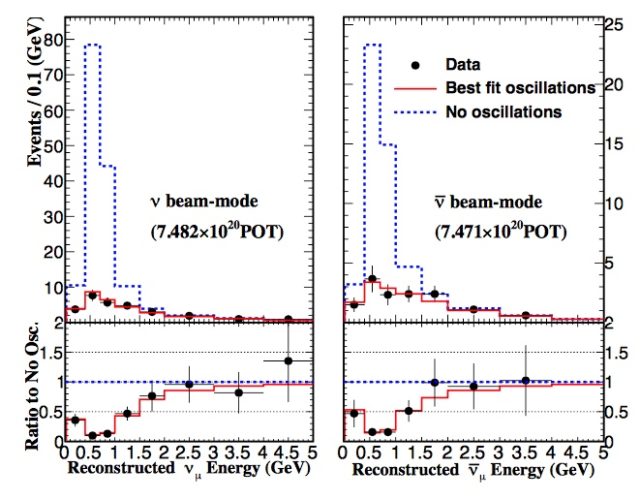
Top panels show the reconstructed energy distribution of the 135 far detector νμ-CCQE candidate events (left) and 66 ν̅μ-CCQE candidate events (right), with predicted spectra for best fit and no oscillation cases. Bottom panels show the ratio to unoscillated predictions.
日本語:
We report measurements by the T2K experiment of the parameters θ23 and ∆m232 governing the disappearance of muon neutrinos and antineutrinos in the three flavor neutrino oscillation model. Utilizing the ability of the experiment to run with either a mainly neutrino or a mainly antineutrino beam, the parameters are measured separately for neutrinos and antineutrinos. Using 7.482 × 1020 POT in neutrino running mode and 7.471 × 1020 POT in antineutrino mode, T2K obtains sin2(θ23) = 0.51+0.08−0.07 and ∆m232 = 2.53+0.15−0.13 × 10−3 eV2/c4 for neutrinos, and sin2(θ̅23) = 0.47+0.25−0.07 and ∆m̅232 = 2.55+0.33−0.27 × 10−3 eV2/c4 for antineutrinos (assuming normal mass ordering). No significant differences between the values of the parameters describing the disappearance of muon neutrinos and antineutrinos were observed.

Top panels show the reconstructed energy distribution of the 135 far detector νμ-CCQE candidate events (left) and 66 ν̅μ-CCQE candidate events (right), with predicted spectra for best fit and no oscillation cases. Bottom panels show the ratio to unoscillated predictions.
Combined Analysis of Neutrino and Antineutrino Oscillations at T2K
